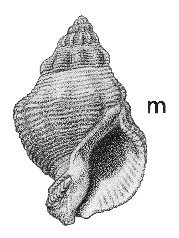
Revised descriptions of New Zealand Cenozoic Mollusca from Beu and Maxwell (1990)

 | Revised descriptions of New Zealand Cenozoic Mollusca from Beu and Maxwell (1990) | 
|
  (Pl. 21m): GS951A, J41/f8475, Target Gully Shellbed, Oamaru, Altonian (GNS) |
Beu & Maxwell (1990): Chapter 11; p. 198; pl. 21 m.
Synonymy: Neptunaea (Sipho) costatus Hutton 1877b, p. 594 (not of Link, 1807); Siphonalia costata; Aethocola costata; Nassicola contractu Finlay of Finlay 1930a, p. 43 (in part, not of Finlay 1926b); Nassicola finlayi Beu & Maxwell 1990, p. 198
Type species (as N. costata) of Nassicola Finlay, 1926
Classification: Buccinulidae
Description: Size moderate for subfamily (height 30-35 mm), cominelliform, spire about 0.4 total height. Protoconch narrowly conical, of 3 lightly convex whorls, last quarter whorl with a few weak opisthocline axial costellae and a fine spiral thread margining lower suture, otherwise smooth. Teleoconch of 5-6 whorls, early whorls convex, later whorls becoming bluntly shouldered near middle through development of a concave sutural ramp, periphery well rounded; last whorl gently and evenly convex below periphery, neck short and strongly twisted. Axial sculpture of well spaced, prominent, rounded costae, reaching from suture to suture on early whorls but becoming obsolete on ramp on later whorls, and extending down onto upper part of base on last whorl, in some shells reduced to large peripheral nodules on last half whorl; 9-12 costae on penultimate whorl. Spiral sculpture commencing as about 4 thin cords, additional cords appearing during growth, later whorls covered with narrow, low cords with considerably wider interspaces, those on ramp noticeably narrower than those below, some cords with interstitial threads. Aperture ovate, columella almost straight above, sharply twisted to left and away from aperture below to form short, strongly notched siphonal canal. Fasciole prominent, of squarish section, margined above by a sharp ridge, below by a more rounded one. Inner lip quite thickly callused in mature shells, callus extending to end of siphonal canal; outer lip thin, prosocline, almost straight except for shallow indentation near lower end, leading edge finely crenulate, bearing narrow lirae within.
Comparison: Nassicola finlayi is superficially similar to N. contracta (Lillburnian-Waiauan, Clifden) but is distinguished by its broader and lower spire, its less well defined shoulder angulation, and in lacking a basal subangulation, so that the last whorl is convex from periphery to neck rather than slightly but distinctly flattened on the sides.
Finlay (1926b, p. 236) originally accepted N. costata as a distinct species, but later (Finlay 1930a, p.43), when he discovered that Hutton's name is preoccupied, considered it to be not worth distinguishing from N. contracta, and accordingly did not propose a replacement name. The differences between the North Otago and South Canterbury Nassicola on the one hand, and Clifden shells on the other, are rather subtle but apparently constant, and Beu & Maxwell 91990) therefore proposed the replacement name N. finlayi for the preoccupied Neptunaea costatus Hutton, 1877, the species occurring in North Otago and South Canterbury. It is interesting to note that Nassicola from Altonian localities in North Canterbury (e.g. Weka Creek and Tommy's Creek) are more like N. contracta than N. finlayi, suggesting that these species were warm-water (N. contracta) and cool-water (N. finlayi) forms respectively. The status of other Miocene nominal species of Nassicola is less clear, however; both N. nassa (Altonian, Clifden) and N. speighti (Waiauan, Burnt Hill, North Canterbury) have a similar whorl profile to N. contracta and seem to differ in only minor sculptural details. N. cingulifer (Clifdenian, Muddy Creek, Gisborne) differs markedly from other Nassicola species by its small size (height 19 mm), its pronounced subsutural fold and its less strongly projecting fasciole. Its protoconch is unknown, and it is possibly a species of Cominella rather than of Nassicola.
Nassicola is an endemic genus with a range of Wangaloan (N. sublurida) to Waipipian (N. ultima; Pl. 37 m). Although originally classed as a subgenus of Austrofusus (i.e. Aethocola), it differs sufficiently (particularly in having a relatively short siphonal canal and a squarish fasciole) to warrant generic rank (Finlay 1930a, p. 43; Beu 1973b, p. 324). In many ways it can be considered the analogue of Aethocola among Cominella-like genera, as it contains essentially Cominella-like species with a small, conical, polygyrate protoconch as in Aethocola.
Distribution: Altonian; Mount Harris Formation, Mt Harris (type) and several other localities in North Otago and South Canterbury, mostly in shallow-water sandstone and shellbeds.
Cite this publication as: "A.G. Beu and J.I. Raine (2009). Revised
descriptions of New Zealand Cenozoic Mollusca from Beu and Maxwell (1990). GNS
Science miscellaneous series no. 27."
© GNS Science, 2009
ISBN
978-0-478-19705-1
ISSN 1177-2441
(Included with a PDF facsimile file
copy of New Zealand Geological Survey Paleontological Bulletin 58 in CD version
from: Publications Officer, GNS Science, P.O. Box 30368 Lower Hutt, New
Zealand)